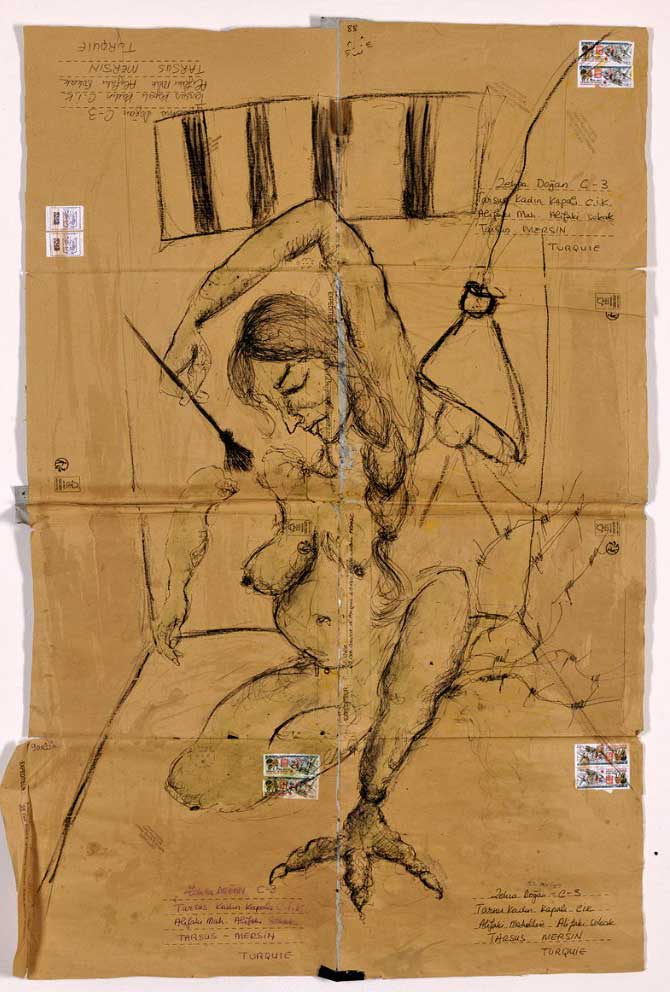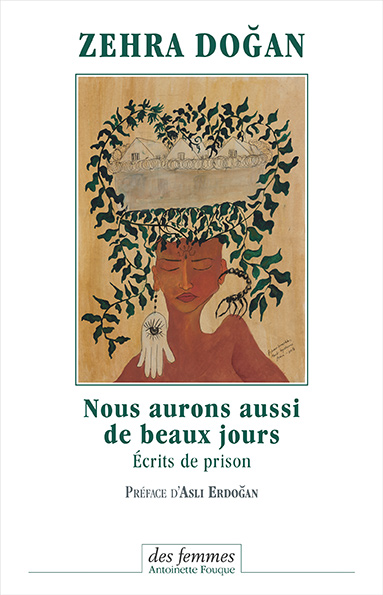Some of Zehra Doğan’s prison writings will be published in French, end of October 2019, by Editions des Femmes – Antoinette Fouque, under the title “Nous aurons aussi de beaux jours”.
Note to the English translation:
Zehra Doğan’s book is being published in French. So why is Kedistan providing an English translation to this information? For two reasons: the first being that many English-speakers read French, and enjoy doing so. Secondly, for those who do not understand French, there may exist some interest in seeing the book’s publication in English translation. In the meantime, here is what Kedistan has to say about Nous aurons aussi de beaux jours (We will also know fine days).
Français | English | Castellano
While Zehra’s visual works done under censorship in prison were escaping from Turkey, as had been the case for those of her clandestine period in Istanbul prior to her definitive arrest in 2017, she was also writing, writing… An abundant correspondence, interrupted by periods of prohibition, led to covering a vast number of pages for close to three years.
Letters sent to her were written on wrapping paper Zehra could use for her drawings. The letters she wrote described the inner world of the prison, the solid community in the women’s quarters of the Gaol in Amed, incarcerated lives like peeling walls that invite interpretation, just as do coffee grounds. The letters are filled with life, like flowing water. The words sometimes turn into images, other times into prison sessions of philosophy as once happened in coffee houses, sometimes they speak of the upright woman, the prisoner both raging and free. There is no lack of poetry, nor are children absent either. And there are more words surging forth than the number of bars in the work Banksy created in solidarity with her.

Zehra Doğan 2019
photo by Jef Rabillon
Zehra writes the way she draws, with her guts as a woman. And when we finally met after her release last February, I knew her already, proud, free, obstinate only too often reasonably so, and persistent as an artist. Watching her create always causes wonderment at the apparent ease of her movements, as forms emerge, as the techniques acquired in jail in the absence of all supplies, give life… We find the same apparent ease in her writing. “I would have written better, had I known…” she says.
These many letters form a web filled with anecdotes, fragments of the lives of her co-detainees, childhood memories, charges against patriarchy, political cries and, most of all, Kurdish heart, Kurdish colors and the power of hope…“We will also know fine days.”
At the end of 2018, during an exhibition of Zehra’s works, Aslı Erdoğan wrote what follows:
“They say a human being must write with the body, a naked body, a bared one…Because it is the blood’s miracle, to send words into life…
Seventy years ago, in concentration camps, some artists wrote poems on toilet paper and painted with their blood. Today, in Turkish jails, there is Zehra Doğan. Who, because her supplies are conficsated, paints with her blood. And who, because her works are confiscated, bleeds again and again.
Creating a brand new world — this will be the miracle of blood, where everything will recover its true meaning!
A nostalgic embrace to Zehra and to all the other friends in jail. We, prisoners, manage to embrace in other ways.”
Today, this tormented soul, signs the preface to these prison writings. These two woman have done so much in order to reveal the unsayable to the world that it is only natural they should meet here.

These days, Zehra Doğan is travelling through parts of Europe, the way her escaped works did before her. There will be no lack of exhibitions in 2020. Kedistan will report on them. Zehra has turned into a Kurdish nomad. As she did at the Tate Exchange in London, as soon as she came of of jail, she is unceasingly archiving and denouncing the negation of Kurds, the unpunished massacres, the cultural obliteration. Her nomadism will also feed her creativity. She has no lack of projects, for herself and most of all for her militant activism, her journalistic fiber… Zehra is in the adolescence of her art, of her power as a fighting woman. She has not finished surprising us.
And I am proud and honored to have put French words on her texts, along with Naz who struggled so strenuously with this living matter to translate it from the Turkish, and who did not wish to keep this correspondence to herself. Of course, Zehra would have preferred writing in Kurdish…But her tongue is forbidden and discriminated against, just as she was forbidden paintbrushes for over two years.
Kedistan relies on its readers to act as the book’s best ambassadors. As of today, everyone can pre-order from their local booksellers.
Must I repeat that it is a profoundly feminist and political book, filled with the poetry of the living, as would be the ivy escaping along the walls.

Zehra Doğan 2019
Natural pigments on canvas. 92x97 cm
Presently on exhibition at Corbata Rosa – Rochefort sur Loire
photo by Jef Rabillon




